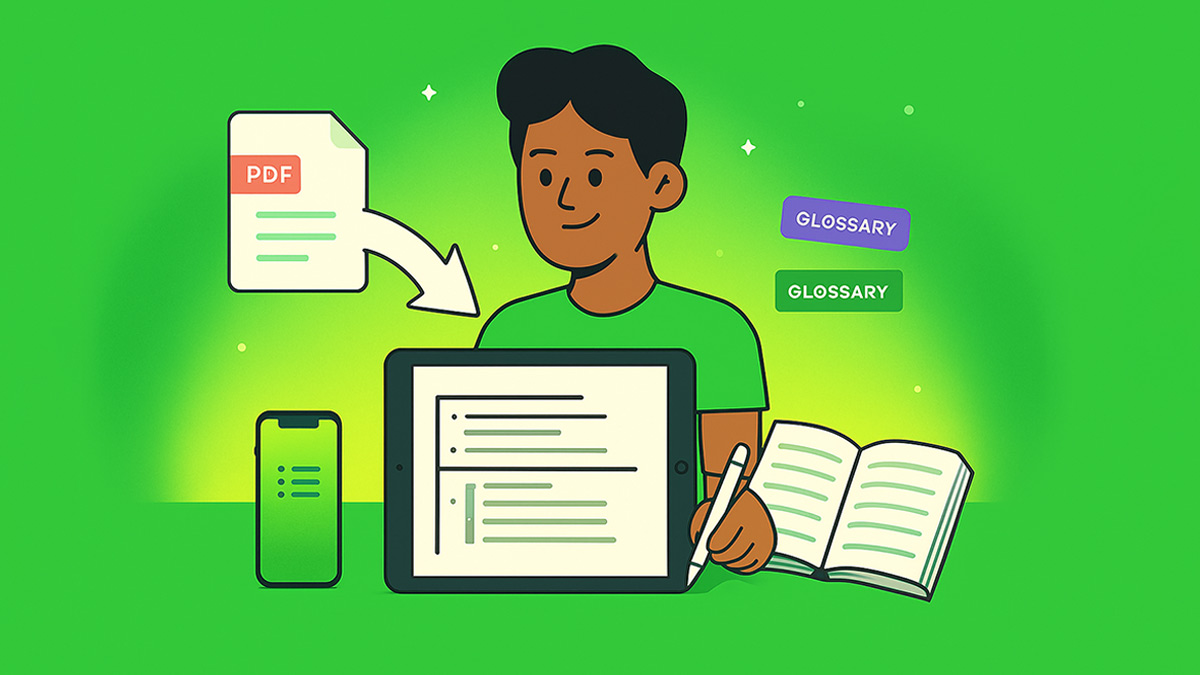PDF to notes Gemini turns dense academic PDFs into structured outlines, glossaries, and summaries fast. Benefits: cleaner study notes, exam-focused highlights, and consistent formatting across chapters. Try our free AI note taker here. Recent studies show generative AI can reduce task time ~40% while improving quality (Science, 2023; HBS/BCG, 2023).
What Are PDF to Notes Prompts?
These prompts convert academic PDFs into usable outlines, summaries, glossaries, and study packs using Gemini. They’re built for high school and college students, teachers, and professionals who want fast, structured notes aligned to exams.
They differ from study guide prompts and quiz prompts by extracting structure from the source PDF instead of generating new practice items from scratch.
How to Use These PDF File AI Prompts
Pick 3–5 prompts, upload your PDF to Gemini, paste the prompt, then run section by section. Export to Google Docs or CSV. New to AI note-taking? Read the Beginner’s Guide to AI Note-Taking. Also see Organized Notes and our AI Study Guide Generator.
PDF Summary: Tiles, Headlines, Metadata (1–20)
These AI PDF file prompts pull titles, headings, page ranges, and must-study areas so later summaries stay accurate and exam-ready.
- Using the PDF attached. Summarize it with great organization and identify the document title, authors, year, edition, and academic discipline.
- Extract the abstract and derive three plain-language learning goals.
- Detect document type and estimate reading difficulty for undergraduates.
- Outline the table of contents with page ranges and nested levels.
- Flag pages dense with formulas, figures, or tables needing special handling.
- Extract all section headers and normalize them to H1–H3 hierarchy.
- Generate APA and IEEE citations from embedded PDF metadata fields.
- Estimate total reading time at 200 wpm and add time for diagrams.
- List prerequisite concepts and insert placeholders for glossary links.
- Identify the core research question and variables if empirical.
- Pull keywords from metadata and first two pages combined.
- Detect errata or heavy footnotes requiring extra verification.
- Find callout boxes or sidebars and summarize their key ideas.
- Extract figure captions and map each caption to its parent section.
- Build a difficulty-aware reading plan with checkpoints and ranges.
- Generate a skim-first checklist for the most high-yield sections.
- Compute repeated-term frequencies to infer emphasis across pages.
- Locate appendices and summarize their contents and intended use.
- Identify limitations or future-work statements with page numbers.
- Extract funding sources or conflict-of-interest disclosures.
Outline & Headings to Study Map (21–40)
Turn raw structure into a navigable outline. Produce hierarchical headings, time estimates, and alignment with your syllabus or slides.
- Create a hierarchical H1–H4 outline with page anchors for navigation.
- Collapse the outline into ten bullet key points for preview.
- Expand each heading into two-sentence summaries using evidence only.
- Add guiding questions under each heading to focus active reading.
- Mark sections most likely on exams and justify each selection.
- Convert the outline into Cornell Notes cues and notes columns.
- Draft a 12–15 slide deck outline with titles and key bullets.
- Map headings to syllabus weeks and list alignment overlaps.
- Produce a comparison table of models with assumptions and contexts.
- Tag sections as theory, method, results, discussion, or practice.
- Pull argumentative claims per heading with their supporting citations.
- Identify transition and signposting phrases between major sections.
- Generate a roadmap from foundational to advanced subsections.
- Provide simple analogies for each core heading to aid memory.
- Suggest diagram types for complex sections requiring visualization.
- Add time estimates per section for a two-hour focused session.
- Turn the outline into a one-page prioritized cheat sheet.
- Extract enumerated lists and convert them into actionable checklists.
- Create mind-map JSON nodes for headings and their connections.
- Produce a five-sentence executive summary tied to the outline.
Definitions, Glossary & Key Terms (41–60)
Extract precise vocabulary and convert it into flashcards, CSVs, and plain-language definitions. Lock in core terminology for quizzes and essays.
- List key terms with concise definitions and citation page numbers.
- Rewrite definitions for beginners while preserving academic accuracy.
- Create contrast pairs for commonly confused terms side-by-side.
- Generate example sentences applying each term in real context.
- Add mnemonic hooks for the ten hardest terms to remember.
- Map terms to equations or symbols and explain each variable.
- Export a glossary CSV with term, definition, page, importance rating.
- Replace jargon with plain-language alternatives where appropriate.
- Generate flashcards with term front and definition plus example back.
- Bundle ten terms into a concept tree from basic to advanced.
- Translate the glossary into Spanish while maintaining nuance.
- Suggest visuals to illustrate each key term effectively.
- Link terms to case studies cited within the PDF.
- Flag outdated terminology and propose current scholarly equivalents.
- Extract acronyms with expansions and first-use page numbers.
- Distill five must-know theorems or laws into intuitive summaries.
- Add misconception warnings for terms frequently misused by students.
- Write three probing questions for each critical term to test understanding.
- Rank terms by frequency and conceptual centrality to the chapter.
- Export the glossary as a Markdown table ready for Docs.
Evidence, Figures, Equations & Citations (61–80)
Surface the proof behind claims. Index figures, extract statistics, and build chains of evidence you can reference in assignments.
- Index all figures and tables with titles and distilled key findings.
- Translate one dense figure into a step-by-step verbal explanation.
- List datasets used, including sample sizes and collection methods.
- Capture equations and explain each variable in plain language.
- Extract supporting studies per major claim with inline citations.
- Summarize methods into inputs, procedures, outputs, and limitations.
- Build a chain-of-evidence map linking claims to specific citations.
- Identify contradictory findings and note the authors’ responses.
- Create a reproducibility checklist for a core experiment or analysis.
- Translate statistical results into audience-friendly takeaways with caveats.
- Extract confidence intervals, p-values, and effect sizes where available.
- Note preregistration, open-data, or code-availability statements.
- Generate formatted bibliographies in APA and Chicago styles.
- Measure self-citations versus external citations across references.
- Write three critique questions targeting the study’s methodology.
- Turn a core model into transparent pseudocode steps for comprehension.
- Explain how one figure strengthens or weakens the central thesis.
- Spot hedging or overgeneralization and quote the exact phrasing.
- Cross-reference citations that recur across multiple sections.
- Queue the most influential references for follow-up reading next.
Summaries, Study Guides & Assessments (81–100)
Condense chapters into layered summaries, exam takeaways, and guided study plans. Clean outputs flow into Docs, Slides, and LMS assignments.
- Write a 200-word student-friendly abstract from the chapter’s core ideas.
- Generate section summaries under 120 words with page references.
- Distill five exam-ready takeaways with precise page numbers.
- Create a pros-and-cons table for the central argument or model.
- Summarize at three levels: 50, 150, and 300 words for review.
- Draft a 10-question quiz balanced across Bloom’s levels with answers.
- Plan a weekly study schedule with milestones and accountability checks.
- Write an oral recitation outline for a 5-minute study recap.
- Produce an email-length overview to share with absent classmates.
- Convert key ideas into a case-discussion prompt with guiding questions.
- Draft a teacher-ready lesson outline with objectives and assessments.
- Export summary bullets as CSV formatted for Anki import.
- Propose three interdisciplinary connections worth further exploration.
- Suggest analogies to explain the core idea to a lay audience.
- Write two practice problems with fully worked solutions and hints.
- Predict likely essay prompts based on chapter emphasis and scope.
- Create an infographic brief listing sections and suggested icons.
- Write a teach-back script for explaining the chapter to peers.
- Assemble a one-page formula sheet with definitions and units.
- Draft a 90-second spoken summary script for quick rehearsal.
Practice, Recall & Transfer Tasks (101–120)
Lock in memory with retrieval and transfer. Create spaced repetition, cloze deletions, and applications tied to your PDF.
- Create a spaced-repetition plan for key sections and definitions.
- Generate cloze deletions from critical definitions, formulas, and theorems.
- Author five retrieval practice questions with increasing difficulty tiers.
- Write self-explanation prompts to follow each paragraph you read.
- Use elaborative-interrogation questions to connect ideas to prior knowledge.
- Plan interleaving that mixes this PDF with two related readings.
- Write ten quick-check true/false statements with correct answers.
- Convert key graphs into small data tables for interpretation practice.
- Design think-aloud prompts to monitor comprehension while reading.
- Author micro-assignments under 15 minutes with clear learning goals.
- Create pretest questions to activate schemas before deep reading.
- Generate synthesis prompts connecting two distant PDF sections.
- Provide conditional-if cues for common error patterns and misconceptions.
- Build a Feynman-technique worksheet for the chapter’s core concept.
- Draft a peer-teaching agenda with roles, timing, and outcomes.
- Turn references into verification tasks tracing claims to sources.
- Write reflection prompts linking new learning to your academic goals.
- Prepare an exam-cram list of last-minute refreshers and pitfalls.
- Design transfer tasks applying concepts to a new domain scenario.
- Produce a post-test checklist confirming readiness and remaining gaps.
Advanced Workflow, Export & Automation (121–150)
Move from notes to deliverables. Merge multi-PDF packs, de-duplicate, style, export, and automate study updates with minimal friction.
- Merge multiple PDFs and generate a unified cross-chapter outline.
- Detect duplicate content across PDFs and keep highest-quality version.
- Normalize terminology across sources and produce a master glossary.
- Convert summaries into APA-style annotated bibliography entries.
- Create a Notion import CSV with properties for tags and difficulty.
- Generate Obsidian-ready Markdown with frontmatter and backlinks.
- Style outputs to match a course template with consistent headings.
- Generate a crosswalk aligning PDF topics to syllabus learning outcomes.
- Export a study-plan calendar file with session titles and durations.
- Create a revision log that tracks changes across updated editions.
- Build instructor notes with cautions, misconceptions, and quick checks.
- Generate LMS-ready quiz items with metadata and difficulty labels.
- Export flashcards as TSV with fields for term, definition, example.
- Produce accessibility-friendly notes with alt text and reading order.
- Compress verbose sections into bullet summaries under 80 characters.
- Generate cloze flashcards from summary bullets automatically.
- Map figures to glossary terms and embed cross-links for review.
- Transform chapter summaries into a narrated script for audio review.
- Create a pre-exam one-pager with must-know facts and pitfalls.
- Schedule spaced reminders tied to glossary difficulty ratings.
- Generate rubric criteria for grading a short summary assignment.
- Create an error log capturing misreads, fixes, and source pages.
- Draft a literature-gap list with proposed follow-up questions.
- Convert notes into a 6-slide lightning talk with speaker notes.
- Produce a Q&A bank pairing common misconceptions with corrections.
- Summarize ethical considerations and potential misuse of findings.
- Generate cross-disciplinary applications for two non-obvious fields.
- Output a clean bibliography with DOIs and hyperlink checks.
- Create a printable booklet layout with margins and page breaks.
- Provide a final audit checklist verifying accuracy against the source.
Printable & Offline Options
Print any section or export to PDF for offline study. Teachers can distribute classroom-friendly notes and glossaries. For more sets, visit the Student Prompts Hub.
Related Categories
FAQ
How accurate is Gemini at extracting outlines from PDFs?
Accuracy depends on PDF quality and structure. Text-based PDFs with clear headings extract well. Scanned or multi-column layouts may need OCR and manual checks. Use prompts 21–27 to normalize headings and verify against the original.
What’s the best workflow for long textbooks?
Process by chapter using prompts 1–6, 21–24, and 81–86. Export each chapter’s outline and glossary to one master Doc. Apply spaced-repetition prompts 101–103 weekly to prevent duplication and boost recall.
Can I trust AI-generated summaries for exams?
Treat summaries as a first pass. Cross-check claims with prompts 65–71. Evidence shows AI boosts speed and quality, but human verification improves accuracy and retention (Microsoft Research, 2025).
Does Gemini support PDF summaries in Google Drive?
Yes. Workspace updates add summary cards for Drive PDFs. Use these prompts for deeper outlines, glossaries, and evidence tracking beyond default summaries.
How accurate is Gemini at extracting outlines from PDFs?
Text-based PDFs with clear headings extract well. Use prompts 21–27 to normalize, then verify against the original.
What’s the best workflow for long textbooks?
Process by chapter; export to a master Doc; reinforce weekly with 101–103.
Can I trust AI summaries for exams?
Use summaries as a first pass. Confirm with prompts 65–71 and original sources.
Does Gemini support PDF summaries in Drive?
Yes. Use these prompts for deeper structure and evidence tracking.
Final Thoughts
These 150 prompts extract outlines, glossaries, evidence, and exam-ready summaries from any academic PDF. Combine AI outputs with retrieval practice for durable learning. Want more? Start AI note-taking instantly with our AI note taker or build a custom pack with the AI Study Guide Generator.
References
- Noy & Zhang, 2023 (Science)
- Dell’Acqua et al., 2023 (HBS/BCG)
- Maldonado et al., 2025 (Microsoft Research)
::contentReference[oaicite:0]{index=0}



